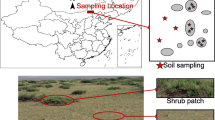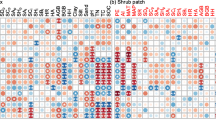Abstract
Shrub encroachment frequently occurs in arid and semi-arid grasslands worldwide and affects the regional carbon balance. Many previous studies have revealed the effects of shrub encroachment on bulk carbon content of grasslands, but molecular evidence is surprisingly lacking. In this study, we examined the chemical composition of plant tissues and soil organic carbon (SOC), and soil microbial communities to identify the effects of shrub (Caragana microphylla) encroachment on SOC storage in the top layer (0–10 cm) along a gradient of natural shrub cover in the grasslands of Inner Mongolia. We found that SOC in the shrub patches was derived mainly from leaves, whereas SOC in the grassy matrix was composed of a mixture of fresh root- and leaf-derived compounds. Compared with pure grassland, the SOC decreased by 29% in the shrub-encroached grasslands (SEGs), and this decrease was enhanced by increasing shrub cover. We also found that free lipids and lignin-derived phenols increased while the ratios of ω-C18/∑C18 and suberin/cutin decreased with increasing shrub cover. In addition, the ratios of fungal to bacterial phospholipid fatty acids (PLFAs) and gram-negative to gram-positive bacterial PLFAs decreased with increasing shrub cover. These results indicate that the encroachment of nitrogen-rich legume shrubs can lead to carbon loss by altering the chemical composition of plant inputs as well as the soil microbial community in grassland ecosystems.





Similar content being viewed by others
References
Alvarez LJ, Epstein HE, Li J et al (2011) Spatial patterns of grasses and shrubs in an arid grassland environment. Ecosphere 2:1–30
Andreetta A, Dignac MF, Carnicelli S (2013) Biological and physico-chemical processes influence cutin and suberin biomarker distribution in two Mediterranean forest soil profiles. Biogeochemistry 112:41–58
Angst G, John S, Mueller CW et al (2016) Tracing the sources and spatial distribution of organic carbon in subsoils using a multi-biomarker approach. Sci Rep 6
Archer S, Boutton TW, Hibbard KA (2001) Trees in grasslands: biogeochemical consequences of woody plant expansion. In: Schulze ED et al (eds) Global biogeochemical cycles in the climate system. A Harcourt Science and Technology Company, San Diego, pp 115–138
Armas-Herrera CM, Dignac MF, Rumpel C et al (2016) Management effects on composition and dynamics of cutin and suberin in topsoil under agricultural use. Eur J Soil Sci 67:360–373
Asner GP, Heidebrecht KB (2005) Desertification alters regional ecosystem–climate interactions. Glob Change Biol 11:182–194
Bai E, Boutton TW, Liu F et al (2013) 15N isoscapes in a subtropical savanna parkland: spatial-temporal perspectives. Ecosphere 4:1–17
Bailey RG (1996) Ecosystem geography. Springer, New York
Barger NN, Archer SR, Campbell JL et al (2011) Woody plant proliferation in North American drylands: a synthesis of impacts on ecosystem carbon balance. J Geophys Res 116:G4
Blaser WJ, Shanungu GK, Edwards PJ et al (2014) Woody encroachment reduces nutrient limitation and promotes soil carbon sequestration. Ecol Evol 4:1423–1438
Bligh EG, Dyer WJ (1959) A rapid method of total lipid extraction and purification. Can J Biochem Physiol 37:911–917
Carbone MS, Trumbore SE (2007) Contribution of new photosynthetic assimilates to respiration by perennial grasses and shrubs: residence times and allocation patterns. New Phytol 176:124–135
Casper BB, Jackson RB (1997) Plant competition underground. Annu Rev Ecol Syst 28:545–570
Chen L, Li H, Zhang P et al (2015) Climate and native grassland vegetation as drivers of the community structures of shrub-encroached grasslands in Inner Mongolia, China. Landscape Ecol 30:1627–1641
Chen D, Pan Q, Bai Y et al (2016) Effects of plant functional group loss on soil biota and net ecosystem exchange: a plant removal experiment in the Mongolian grassland. J Ecol 104:734–743
Chigineva NI, Aleksandrova AV, Tiunov AV (2009) The addition of labile carbon alters litter fungal communities and decreases litter decomposition rates. Appl Soil Ecol 42:264–270
Crow SE, Lajtha K, Filley TR et al (2009) Sources of plant-derived carbon and stability of organic matter in soil: implications for global change. Glob Change Biol 15:2003–2019
DeMarco J, Filley T, Throop HL (2016) Patterns of woody plant-derived soil carbon losses and persistence after brush management in a semi-arid grassland. Plant Soil 406:277–293
Dempsey MA, Fisk MC, Fahey TJ (2011) Earthworms increase the ratio of bacteria to fungi in northern hardwood forest soils, primarily by eliminating the organic horizon. Soil Biol Biochem 43:2135–2141
D’Odorico P, Okin GS, Bestelmeyer BT (2012) A synthetic review of feedbacks and drivers of shrub encroachment in arid grasslands. Ecohydrology 5:520–530
Eldridge DJ, Bowker MA, Maestre FT et al (2011) Impacts of shrub encroachment on ecosystem structure and functioning: towards a global synthesis. Ecol Lett 14:709–722
Fang J, Bai Y, Wu J (2015) Towards a better understanding of landscape patterns and ecosystem processes of the Mongolian Plateau. Landscape Ecol 30:1573–1578
Feng X, Simpson AJ, Schlesinger WH et al (2010) Altered microbial community structure and organic matter composition under elevated CO2 and N fertilization in the duke forest. Glob Change Biol 16:2104–2116
Feng X, Gustafsson Ö, Holmes RM et al (2015) Multi-molecular tracers of terrestrial carbon transfer across the pan-Arctic: comparison of hydrolyzable components with plant wax lipids and lignin phenols. Biogeosciences 12:4841–4860
Fierer N, Jackson RB (2006) The diversity and biogeography of soil bacterial communities. Proc Natl Acad Sci USA 103:626–631
Filley TR, Boutton TW, Liao JD et al (2008) Chemical changes to nonaggregated particulate soil organic matter following grassland-to-woodland transition in a subtropical savanna. J Geophys Res 113. doi:10.1029/2007jg000564
Fontaine S, Barot S, Barre P et al (2007) Stability of organic carbon in deep soil layers controlled by fresh carbon supply. Nature 450:277–280
Goñi MA, Hedges JI (1990) The diagenetic behavior of cutin acids in buried conifer needles and sediments from a coastal marine environment. Geochim Cosmochim Acta 54:3083–3093
González-Roglich M, Swenson JJ, Jobbágy EG et al (2014) Shifting carbon pools along a plant cover gradient in woody encroached savannas of central Argentina. For Ecol Manag 331:71–78
Hibbard K, Archer S, Schimel D et al (2001) Biogeochemical changes accompanying woody plant encroachment in a subtropical savanna. Ecology 82:1999–2011
Jackson RB, Banner JL, Jobbágy EG et al (2002) Ecosystem carbon loss with woody plant invasion of grasslands. Nature 418:623–626
Knapp AK, Briggs JM, Collins SL et al (2008) Shrub encroachment in North American grasslands: shifts in growth form dominance rapidly alters control of ecosystem carbon inputs. Glob Change Biol 14:615–623
Kögel-Knabner I (2002) The macromolecular organic composition of plant and microbial residues as inputs to soil organic matter. Soil Biol Biochem 34:139–162
Kuzyakov Y (2010) Priming effects: interactions between living and dead organic matter. Soil Biol Biochem 42:1363–1371
Lett MS, Knapp AK, Briggs JM et al (2004) Influence of shrub encroachment on aboveground net primary productivity and carbon and nitrogen pools in a mesic grassland. Can J Bot 82:1363–1370
Li P, Wang N, He W et al (2008) Fertile islands under Artemisia ordosica in inland dunes of northern China: effects of habitats and plant developmental stages. J Arid Environ 72:953–963
Li H, Shen H, Chen L et al (2016) Effects of shrub encroachment on soil organic carbon in global grasslands. Sci Rep 6:28974
Li H, Zhang J, Hu H et al (2017) Shift in soil microbial communities with shrub encroachment in Inner Mongolia grasslands, China. Eur J Soil Biol 79:40–47
Liu F, Wu X, Bai E et al (2011) Quantifying soil organic carbon in complex landscapes: an example of grassland undergoing encroachment of woody plants. Glob Change Biol 17:1119–1129
Maestre FT, Bowker MA, Puche MD et al (2009) Shrub encroachment can reverse desertification in semi-arid Mediterranean grasslands. Ecol Lett 12:930–941
Maestre FT, Quero JL, Gotelli NJ et al (2012) Plant Species Richness and Ecosystem Multifunctionality in Global Drylands. Science 335:214–217
Maestre FT, Delgado-Baquerizo M, Jeffries TC et al (2015) Increasing aridity reduces soil microbial diversity and abundance in global drylands. Proc Natl Acad Sci USA 112:15684–15689
Montané F, Romanyà J, Rovira P et al (2010) Aboveground litter quality changes may drive soil organic carbon increase after shrub encroachment into mountain grasslands. Plant Soil 337:151–165
Nottingham AT, Griffiths H, Chamberlain PM et al (2009) Soil priming by sugar and leaf-litter substrates: a link to microbial groups. Appl Soil Ecol 42:183–190
Oelofse M, Birch-Thomsen T, Magid J et al (2016) The impact of black wattle encroachment of indigenous grasslands on soil carbon, Eastern Cape, South Africa. Biol Invasions 18:445–456
Otto A, Simpson MJ (2006) Evaluation of CuO oxidation parameters for determining the source and stage of lignin degradation in soil. Biogeochemistry 80:121–142
Paul EA, Morris SJ, Sixad J et al (2003) Interpretation of soil carbon and nitrogen dynamics in agricultural and afforested soils. Soil Sci Soc Am J 67:1620–1628
Peng H, Li X, Jiang Z et al (2013) Shrub encroachment with increasing anthropogenic disturbance in the semiarid Inner Mongolian grasslands of China. CATENA 109:39–48
Pisani O, Hills KM, Courtier-Murias D et al (2013) Molecular level analysis of long term vegetative shifts and relationships to soil organic matter composition. Org Geochem 62:7–16
Ratajczak Z, Nippert JB, Collins SL (2012) Woody encroachment decreases diversity across North American grasslands and savannas. Ecology 93:697–703
Scharlemann JPW, Tanner EVJ, Hiederer R et al (2014) Global soil carbon: understanding and managing the largest terrestrial carbon pool. Carbon Manag 5:81–91
Schlesinger WH, Reynolds JF, Cunningham GL et al (1990) Biological feedbacks in global desertification. Science 247:1043–1048
Schlesinger WH, Raikes JA, Hartley AE et al (1996) On the spatial pattern of soil nutrients in desert ecosystems. Ecology 77:364–374
Schmidt MW, Torn MS, Abiven S et al (2011) Persistence of soil organic matter as an ecosystem property. Nature 478:49–56
Springsteen A, Loya W, Liebig M et al (2010) Soil carbon and nitrogen across a chronosequence of woody plant expansion in North Dakota. Plant Soil 328:369–379
Sutherland WJ, Freckleton RP, Godfray HCJ et al (2013) Identification of 100 fundamental ecological questions. J Ecol 101:58–67
Tamura M, Tharayil N (2014) Plant litter chemistry and microbial priming regulate the accrual, composition and stability of soil carbon in invaded ecosystems. New Phytol 203:110–124
Throop HL, Archer SR (2008) Shrub (Prosopis velutina) encroachment in a semidesert grassland: spatial–temporal changes in soil organic carbon and nitrogen pools. Glob Change Biol 14:2420–2431
Van Auken OW (2009) Causes and consequences of woody plant encroachment into western North American grasslands. J Environ Manage 90:2931–2942
Whittinghill KA, Currie WS, Zak DR et al (2012) Anthropogenic N deposition increases soil C storage by decreasing the extent of litter decay: analysis of field observations with an ecosystem model. Ecosystems 15:450–461
Willers C, Jansen van Rensburg PJ, Claassens S (2015) Phospholipid fatty acid profiling of microbial communities-a review of interpretations and recent applications. J Appl Microbiol 119:1207–1218
**ong X, Han X (2005) Spatial heterogeneity in soil carbon and nitrogen resources, caused by Caragana microphylla, in the thicketization of semiarid grassland, Inner Mongolia. Acta Ecolog ica Sinica 25:1678–1683
Zhao L, Wu W, Xu X et al (2014) Soil organic matter dynamics under different land use in grasslands in Inner Mongolia (northern China). Biogeosciences 11:5103–5113
Zhou Y, Boutton TW, Wu XB et al (2017) Soil carbon response to woody plant encroachment: importance of spatial heterogeneity and deep soil storage. J Ecol doi: 10.1111/1365-2745.12770
Acknowledgements
This study was funded by the National Natural Science Foundation of China (31330012, 31470525), the National Basic Research Program of China on Global Change (2014CB954001), and the China Postdoctoral Science Foundation (2016M591282).
Author information
Authors and Affiliations
Corresponding author
Additional information
Responsible Editor: Edith Bai.
Electronic supplementary material
Below is the link to the electronic supplementary material.
Rights and permissions
About this article
Cite this article
Zhou, L., Li, H., Shen, H. et al. Shrub-encroachment induced alterations in input chemistry and soil microbial community affect topsoil organic carbon in an Inner Mongolian grassland. Biogeochemistry 136, 311–324 (2017). https://doi.org/10.1007/s10533-017-0396-8
Received:
Accepted:
Published:
Issue Date:
DOI: https://doi.org/10.1007/s10533-017-0396-8




